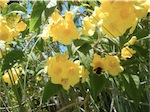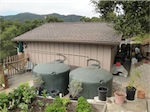As global warming and toxic pollution make the headlines, people are becoming more concerned about the effects human activities have on the natural world that supports us. Although the problems are massive in scale, each of us can have an influence on that part of the world that we are closest to – our gardens. By taking some simple actions in our own backyards, we can contribute to the health of our ecosystem and the world as a whole.
Some traditional landscape practices have negative effects on the environment – native plant removal, destruction of healthy soils, water consumption, and overuse of toxic materials, to name a few. Fortunately, there are many alternative practices that reduce negative effects, enhance ecological health, and contribute to the human experience of natural beauty in the home garden.
Here are some principles, and a few specific techniques:
Conserve resources
Consider the source of your building materials. What ecological impacts, such as habitat destruction and fossil fuel consumption, are associated with their production and transport to your home? Using locally produced materials will generally conserve resources, and lessen fuel consumption.
Do you have good building materials in your garden that could be saved and creatively reused? Transformation of a broken concrete or stone patio into a beautiful dry-stacked retaining wall is one example.
Water conservation has become a fact of life. Drip irrigation allows for precise application of water with less evaporation than traditional spray systems. Recently introduced “smart” irrigation controllers measure changes in weather and automatically adjust irrigation amounts. Household gray water can be redirected to the garden. California native plants are perfectly adapted to our Mediterranean climate. Accustomed to our seasonal rain and drought cycle, they do not require abundant summer water.
Reduce pollution
Soluble fertilizers, toxic pesticides, and eroded soil wash into our local creeks and bay, affecting the health of our aquatic environment.
With good planning, we can lessen the amount of pollution we produce in our gardens. Careful plant selection and placement reduces our reliance on fertilizers and pesticides, and lessens constant trimming and disposal of excess growth. Garden clippings can be kept on-site and use them as mulch or compost for non-toxic weed control and soil nutrition. With careful grading, storm water can soak in to recharge ground water reserves, rather than running off to the nearest stream, where it can cause erosion damage.
Enhance habitat value
The garden can be a natural wonderland, full of life and mystery, a joy to discover and experience. We can attract native wildlife by introducing the essentials of good habitat – food, water, and shelter.
Birdbaths and small fountains invite birds and butterflies, and give us the elemental joy of being close to water, even in a drought-adapted garden.
Native plantings provide the basics of life for many species that evolved over thousands of years in this area. If you plant it, they will come!
Humans and Nature
And what about human habitat? The garden can bring us food from a vegetable bed or home orchard and offer shelter from heat and rain. An extension of the home, it provides a place for socializing, or restful retreat away from our fast-paced lives.
The garden is a great place for learning about the world we live in. Here, children (and grownups) can learn skills of quiet observation and appreciation of nature.
A well designed, carefully constructed, and consciously maintained garden can be your contribution to help heal our environmental problems, and it can be a joyous and comfortable experience for you and your family. Consider the possibilities!
- To see more of Michael Thilgen’s & Linda Juratovac’s work or to contact them, visit www.fourdimensionslandscape.com
- Michael was interviewed for an article by the San Francisco Chronicle
- Read also the Gilroy Dispatch’s report on one of the Michael’s many native garden projects: The Myers Garden







